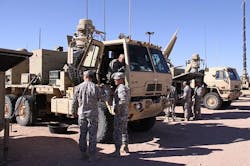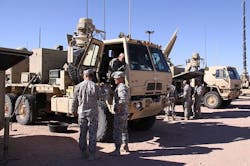Army reaches out to industry for ideas on augmented-reality training for NIE 15.1 this fall
Of primary interest are mature technologies to enable the kind of augmented reality that can enable Army units smaller than companies, as well as individual soldiers, to train at complex battlefield tasks while at their home bases.
Officials of the Army Contracting Command (ACC) in Warren, Mich., on Friday issued a sources-sought notice (W56HZV-151-SOURCES-SOUGHT) for the Army Network Integration Evaluation (NIE) 15.1 demonstrations, which will be in October and November 2014 at Fort Bliss, Texas, and White Sands Missile Range, N.M.
ACC Warren officials issued the notice on behalf of the Army ASA(ALT) System of Systems Engineering and Integration Directorate (SOSE&I) in Warren, Mich.
The Army NIE events are twice-yearly in-field evaluations at Fort Bliss and White Sands designed to further integrate and rapidly progress the Army’s tactical network. The events typically take place in spring and fall.
The focus of NIE 15.1 this fall is on mature solutions to enhance existing network systems capabilities related to home station training and the integrated training environment technologies. These areas have been identified as specific identified gaps in current and evolving Army networked equipment solutions.
Related: Harris Corp. delivers wideband networking to U.S. Army network integration evaluation
To fill this need, Army leaders are looking for technologies in augmented reality (AR) for small units and individual soldiers that can simulate indirect fire and aerial supply delivery during live training exercises, with the ability to support multi-echelon training at home bases when necessary.
Augmented reality involves a live view of a real-world environment in which computer-generated sensory inputs such as sounds, video, graphics, or GPS data augments the real-world view. Symbology projected onto a combat aircraft head-up display is one simple example of augmented reality.
Related: Department of Defense invests in delivering augmented reality technology to foot soldiers
With the help of augmented reality, the information about the surrounding real world becomes interactive and enables users to manipulate the real world as a digital simulation. Artificial information about the environment and its objects can overlay the real-world view.
Army leaders during NIE 15.1 plan to restrict home-base simulation capabilities to the training phase, and will not make them part of the NIE field activities.
At the NIE 15.1 demonstrations and exercises, Army leaders will conduct a scheduled network baseline assessment, so the number and types of new solutions will be restricted to keep unacceptable equipment out of the brigade's networked systems.
A network baseline assessment is a review of an organization’s data and voice communications capability, as well as a review of network designs based on standards, performance, and overall capability. It provides a baseline for future network designs and implementations.
NIE 15.1 this fall will last from two to four weeks, and employ an Army brigade combat team (BCT) at Fort Bliss in El Paso, Texas. The goal is to conduct parallel, systems tests of Army programs, evaluate new network technology capabilities, non-network capabilities, and emerging in-theater capabilities and concepts.
The NIE 15.1 events will include tactical exercises using current force equipment and emerging networked systems.
Companies with the appropriate technology that would like to participate in NIE 15.1 should email white papers no later than 31 Jan. 2013 to the Army at [email protected].
For questions or concerns phone the Army's Tyron Williams at 586-574-8116. More information is online at https://www.fbo.gov/notices/a0e1e0b34f26c7d80f648d14094b8b2c. A Microsoft Word document with NIE 15.1 information is online at https://acquisition.army.mil/asfi/synopsis_attach_viewer.cfm?psolicitationnbr=W56HZV-151-SOURCES-SOUGHT&pseqnbr=431160&pnot_type=SRCSGT.


